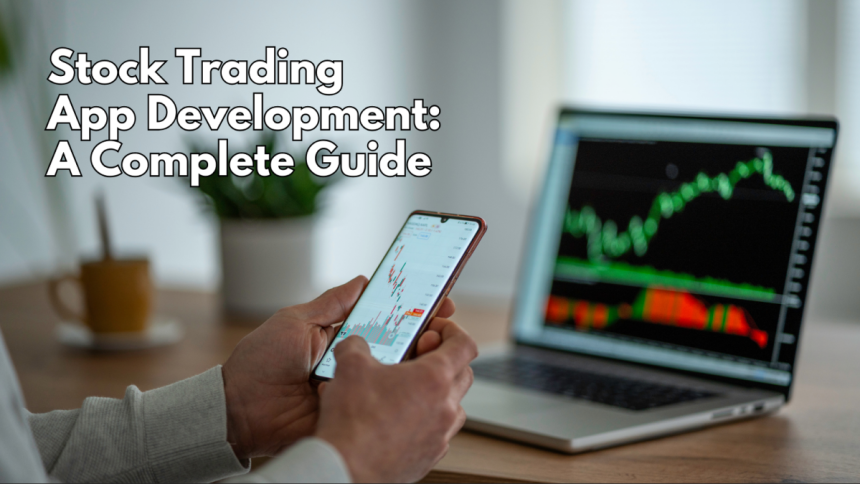Stock trading has been the wellspring for current financial systems and propels economic and individual development. It transformed traditional trading into digital platforms, accessible to everyone out there who owns a smartphone or a computer. In this case, the development of a stock trading app represents a very profitable business for companies due to the growing activity of users who engage more with the new mobile way of trading compared to conventional ones.
In this comprehensive guide, we will be talking about how to successfully, securely, and user-friendly develop a stock trading application. Among the most essential development steps is choosing the right trading strategies and platforms; this lays the base for your application.
Understanding the Stock Trading Market
Before getting into the development phase, it will become very necessary to understand the stock trading market. It is, in essence, a place or an exchange for trading different security instruments like stocks, bonds, and others.
These exchanges, as widely known, include the New York Stock Exchange and NASDAQ, which provide platforms for stock trading software to be used by traders. The market operates based on demand and supply, wherein the prices change every instant due to various factors, such as economic indicators, company performance, and geopolitical events.
Key Features of a Stock Trading App:
There are specific key features that stock trading applications shall bring on board to give out a successful application that meets the user’s expectations and regulatory requirements. These features include:
User registration and authentication: Safe sign-ups and logins are essential, further reinforced with 2FA for added security.
User portfolio management: The user shall be given an easy view and management of their investments.
Live market data: Real-time information about stock prices, market trends, and news.
Trading and Order Management: Facilitate smooth buying and selling of stocks.
Analytics and Reporting: Provide tools to the users so that they are better placed and posed to analyze their performance and generate reports.
Notifications and Alerts: Keep the user abreast with critical events and price changes.
Security Features: Ensure encryption of all data, secure transactions, and adherence to financial regulations.
Steps in Developing a Stock Trading Application
Market Research and Planning
Do proper market research to find out your target audience, competitors, and trends. Then, identify which USPs are going to make your app outstandingly different from others. At this stage, you will have to decide precisely the scope, features, and technical requirements of the app.
Selection of the Right Technology Stack
A proper technology stack is crucial for the performance, safety, and scalability of the app. You can choose:
Front-end: React Native or Flutter for the development of cross-platform.
Back-end: Node.js or Django for robust server-side operations
Database: PostgreSQL or MongoDB for efficient data management
APIs: Integration with financial data providers like Alpha Vantage or IEX Cloud to receive real-time market data.
Designing UI/UX
Designing an intuitive and engaging user interface is very important. UI/UX design must therefore be based on ease of navigation, clarity, and responsiveness. Wireframes and prototypes are instrumental in giving shape to the application and visualizing its layout and functionality.
Development
First, set up the Development Environment, and fix up the required tools. Next, decompose the development process into sprints and focus on the building and testing of individual features. Agile methodology could help in iterative development and continuous improvement.
Testing
To ensure that the app goes smoothly and is secure, rigorous testing is a must. Following are the several types of testing that will be done during the project, including –
Unit Testing: Testing of individual components.
Integration Testing: Making sure different constituents of the app work together.
User Acceptance Testing: Getting feedback from real users in order to make necessary adjustments
Security Testing: Identifying and fixing vulnerabilities
Deployment
After an app passes all of the numerous kinds of tests, it is set for deployment. It essentially includes the configuration of servers, setting up databases, and making sure everything works around for performance. Publish the app on relevant stores like Apple App Store and Google Play Store.
Post-launch Support and Maintenance
Provide ongoing support and maintenance once your app is launched. Be on the lookout for your app’s performance, act upon user feedback, and introduce new updates to fix bugs and bring in new features.
Security Considerations
The requirement for security in the development of stock trading applications is paramount. Strong security measures are critically required to safeguard user data and financial transactions. Two major significant practices in instilling security into the mobile app include:
Data Encryption: This ensures that sensitive data is encrypted to its best so that no unauthorized access may be granted to it.
Authentication Security: More on this is multi-factor authentication to protect the security of login credentials.
Compliance with Regulations: The app shall, of course, have to abide by financial regulations, for example, KYC, AML, etc.
Regular audits: include running regular security audits and vulnerability assessments for the app.

Monetization Strategies
Stock trading apps can be monetized in various ways, for instance:
Commission: Mostly, a small fee against each executed trade.
Subscription Plans: Premium features are to be offered in paid subscription plans.
In-app Advertisements: Push targeted advertisements within the app.
Partnerships: Financial institutions and brokers need collaboration.
Challenges of Stock Trading App Development
Developing a stock trading app comes with its set of challenges. These are expected to include the following:
Regulatory Hurdles: Human wading through the intricate regulatory environment that a financial industry presents
High Competition: Standing out in an already crowded marketplace wherein all the leaders are well-entrenched
Security Risks: Cyber threats are always evolving; hence one has to be at their toes at every instance.
User Trust: The whole and long-lasting win depends on the building up and maintenance of trust amongst its users.
Future Trends in Stock Trading Apps
The future of stock trading apps will most likely be determined by technological innovation and shifts in user preference. Some of the key trends to watch out for include:
Artificial Intelligence: AI for personalized recommendations and predictive analytics.
Blockchain: Tapping into blockchain technology for more security and transparency.
Social Trading: Development of social features that allow each user to follow and copy successful traders.
Virtual Reality (VR): Make a plunge into trading with Virtual reality platforms.
FAQs
How much may it cost to develop a stock trading application?
It may vary greatly depending on the complexity of the application, the features involved, and at what rate works are charged by the development team. The average ranges from $50,000 to $300,000.
How long does it take to build a stock trading application?
A stock trading app takes anywhere from half a year to over one year to be developed, depending on the scope and complexity of the project.
What are the legalities that concern the development of a stock trading app?
The legal requirement in developing a stock trading app is that it has to be compliant with the financial regulations that dictate areas such as data protection, especially KYC, AML, and GDPR. It will always be wiser to consult with a lawyer to be sure one is fully covered.
Conclusion
The development of a stock trading app is multi-faceted and requires proper planning, technical ability, security, and a user experience focus. You will be able to build a stronger, more efficient stock trading application if you have an understanding of the market and technology and if you stick to the standards set by the regulatory bodies. An update in terms of the latest trends and innovations in this financial industry will be needed continuously in order to stay ahead in this competitive marketplace.
Lynn Martelli is an editor at Readability. She received her MFA in Creative Writing from Antioch University and has worked as an editor for over 10 years. Lynn has edited a wide variety of books, including fiction, non-fiction, memoirs, and more. In her free time, Lynn enjoys reading, writing, and spending time with her family and friends.














